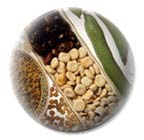- Home
- Introductions

|
Vegetable Seed Production: Seed ProductionYou are here: Seed Production: Principles: Photosynthesis & Seed Production Environmental Requirements for Seed Production Some vegetables require specific photoperiods to induce flowering for successful seed production. This effect is dependent on the length of the photoperiod, which greatly affects seed yield. For example, onion cultivars exhibit a wide range of photoperiod responses and this influences where seed production occurs. Seed production of long-day onions occurs at latitudes greater than 45° N and short-day onions at latitudes no greater than 35° N. Limited seed production also can be accomplished in glasshouses where supplemental light is provided or light excluded to promote flowering. Even when appropriate photoperiods are present, temperatures must be suitable for the completion of the entire life cycle of the crop during the growing season. For vegetable use, onion, radish, broccoli, and cabbage are harvested before flowering occurs. As a result, these crops are grown in regions with cooler temperatures not suitable for seed crops, which require longer seasons and warmer temperatures for maturation. Precipitation amount and distribution also varies for vegetable and seed crops. Many vegetable crops harvested for their vegetative tissues require significant early season rainfall or irrigation for rapid development. Seed crops, in contrast, demand uniform precipitation during development followed by dry conditions during seed maturation. Under late season dry conditions, dependable conditions for seed harvest are possible and pathogen infestations minimized. This is the principal reason much of the vegetable seed production has shifted to the western United States. The Mediterranean climate of the Pacific Northwest assures cool, dry summers and mild, wet winters for optimum development of many biennial seed crops. Southern California and much of Arizona are hot and dry during the summer which is ideal for vegetable seed production. Dry conditions of these locations permit seed crops to be irrigated with adequate moisture at the proper time so that optimum seed quality is achieved. Photosynthesis & Seed Production Many students often forget that carbon (C), hydrogen (H), and oxygen (O) are required mineral nutrients that green plants need to grow and develop. C and O are often forgotten because they are obtained primarily through the air rather than the soil. C, H, and O are essential to plants because they are necessary for photosynthesis. Photosynthesis provides the chemical building blocks or carbon skeletons for plant and seed dry matter accumulation. Anything that limits photosynthesis e.g. drought stress, insect damage, disease, shading, mechanical damage will also reduce plant growth and seed yield. Cultural practices should always be tailored to maximize photosynthesis for best seed production. Please view the following video about photosynthesis.
|